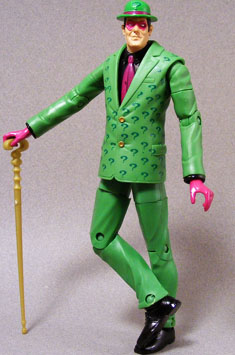|
Created by prolific Batman writer Bill Finger and artist Dick Sprang in the late 1940s, the Riddler didn't become one of the canonical members of the Dark Knight's rogues gallery until Frank Gorshin's popular portrayal of the emerald-clad quizmaster. However, the character never quite found his bliss as a Bat-villain. He shares many aspects of the Joker (humorous verbal gags, a tendency to leave clues, and in the Gorshin and Carrey portrayals, manic behavior) and the Penguin (the Riddler was primarily a thief, not a killer), but lacks the grotesque appearance of either. Writers have often struggled to make the Riddler unique, and he eventually developed into one of Batman's more sympathetic villains, cursed with an unusual variant of obsessive-compulsive disorder. Some writers suggest he is the most brilliant of Batman's foes, having deduced his secret identity, but Ra's Al Ghul is generally accepted as the true counterpart to Batman's genius.
It's not surprising that the most interesting development
 in the Riddler's recent history can be attributed to Paul Dini, the former Batman: The Animated Series scribe who deserves a place alongside Finger, Denny O'Neill, and Frank Miller as one of the greatest writers of the Dark Knight. It was Dini who, in Detective Comics #822, introduced a "reformed" Riddler who now worked as a private investigator (albeit with the occasional sketchy side business). This is a brilliant move and a perfect role for the character; like Catwoman, he's more or less a "good guy" now, but works frequently on the wrong side of the law and isn't above the occasional con job or theft. The animated series is also largely responsible for upgrading the Riddler's look from a skintight jumpsuit to a dapper green business suit with a bowler hat.
in the Riddler's recent history can be attributed to Paul Dini, the former Batman: The Animated Series scribe who deserves a place alongside Finger, Denny O'Neill, and Frank Miller as one of the greatest writers of the Dark Knight. It was Dini who, in Detective Comics #822, introduced a "reformed" Riddler who now worked as a private investigator (albeit with the occasional sketchy side business). This is a brilliant move and a perfect role for the character; like Catwoman, he's more or less a "good guy" now, but works frequently on the wrong side of the law and isn't above the occasional con job or theft. The animated series is also largely responsible for upgrading the Riddler's look from a skintight jumpsuit to a dapper green business suit with a bowler hat.
I wouldn't call the Riddler an "antihero" - that term is so overused these days, it's lost all meaning - but he's become a complex character rather than a goofy one-note supervillain. Therefore, his bio on the DCU packaging is a bit outdated:
Edward Nigma turned his love of puzzles into a career by running a crooked carnival puzzle game. But E. Nigma, yearning for greater glory and wealth, decided to use his love of riddles to match wits with the Gotham City police and Batman, sending them fiendishly complex clues to his forthcoming crimes, crimes committed as... the Riddler!
The Riddler was one of the few major Bat-villains not to get an action figure in Kenner's Super Powers line (though ToyBiz did make a kitbashed version in their late 1980s DC Super Heroes line, using existing Super Powers molds such as the Flash and Green Lantern - a figure young Poe once owned). Despite the Riddler's prominence in Batman's rogues gallery,
 he managed not to receive a figure through Mattel's own DC Superheroes line and all the way through the first four series of DC Universe Classics. But now, finally, we have our Four Horsemen-sculpted Riddler as part of the fifth series of DC Universe Classics. The line is a Wal*Mart exclusive and, as of this writing, incredibly difficult to find (I must again thank yo go re for picking me up a set). [give me your power of attorney. --yo]
he managed not to receive a figure through Mattel's own DC Superheroes line and all the way through the first four series of DC Universe Classics. But now, finally, we have our Four Horsemen-sculpted Riddler as part of the fifth series of DC Universe Classics. The line is a Wal*Mart exclusive and, as of this writing, incredibly difficult to find (I must again thank yo go re for picking me up a set). [give me your power of attorney. --yo]
As should be obvious at first glance, the Riddler is made primarily from the same mold as Clark Kent and Two-Face. It's a little annoying that we're getting a third figure using this mold, but fortunately, the Riddler may be the best use of it yet. Although the sculpt was originally designed for Two-Face, it's Mr. Nigma who best fits the sculpt's thin, lanky look. Early photos of the prototypes had the figure with a normal tie, but sadly, the production figure still has the line down the middle from its Two-Face days.
The only new sculpting for this figure is the head. Like many of their DCSH and DCUC figures,
 the Horsemen appear to have been inspired by the look of the character in the DC animated universe. Riddler has a long face, a tight jaw and a prominent nose, and a smug look on his face. The Horsemen have done a great job making the heroes and villains of the DC Universe distinct and yet true to their depictions in the comics and cartoons (as opposed to, say, making Angel look like Brad Pitt). One minor nitpick is the way the head sits on the neck; it's a little too low, giving the figure something of a hunched appearance and making him look beefier than the character actually is.
the Horsemen appear to have been inspired by the look of the character in the DC animated universe. Riddler has a long face, a tight jaw and a prominent nose, and a smug look on his face. The Horsemen have done a great job making the heroes and villains of the DC Universe distinct and yet true to their depictions in the comics and cartoons (as opposed to, say, making Angel look like Brad Pitt). One minor nitpick is the way the head sits on the neck; it's a little too low, giving the figure something of a hunched appearance and making him look beefier than the character actually is.
While it's clear a number of corners were cut on this Wal*Mart exclusive series, most of the paint work on the Riddler is satisfactory. The face and hat are well done, with very little slop. The printing of the tiny question marks on his torso is well done. Many collectors are disappointed there are no question marks on his sleeves; I seem to recall reading in one of the Mattel Q&As that this was requested by DC Comics, although I couldn't find the reference. In the comics, the Riddler is often depicted without any question marks on his suit except for his hat and tie, but I imagine it would be harder for kids in toy stores to recognize him without all the question marks. This may represent some sort of compromise between Mattel and DC. Or maybe Mattel just wanted to save money on the tampo printing.
The only noticeably bad paint
 application is on his gloves, which are much too glossy and look almost like Edward's wearing latex gloves. For what purpose? I dare not ask for fear of finding out.
application is on his gloves, which are much too glossy and look almost like Edward's wearing latex gloves. For what purpose? I dare not ask for fear of finding out.
The Riddler has the standard DCUC articulation. He has a balljointed neck, which actually has a decent range of motion, something that was lacking on Clark Kent and Two-Face. He also has ball-and-hinge shoulders, hinged elbows, knees and ankles, and swivels at the wrists, biceps, thighs, and waist. Like most figures of characters wearing suits, the bicep and thigh joints look pretty bad when moved out of position, due to the irregular nature of the sculpt. He also has the "h-hinge" joints at the hips, which allow him to spread his legs a bit as well as move them forward and back, though the motion is hindered a bit by the suit jacket.
The figure comes with two accessories:
 his trademark cane with a question-mark-shaped head, and Metallo's head and torso. Unfortunately, the cane is simply molded in yellow plastic and isn't painted at all. It doesn't look nearly as nice as, say, the cane that came with Quick-Fire Joker, and that thing is five years old. It's another sign of the cust-cutting measures that were used on this wave.
his trademark cane with a question-mark-shaped head, and Metallo's head and torso. Unfortunately, the cane is simply molded in yellow plastic and isn't painted at all. It doesn't look nearly as nice as, say, the cane that came with Quick-Fire Joker, and that thing is five years old. It's another sign of the cust-cutting measures that were used on this wave.
 The Metallo chunk is large and detailed, with a few joints hinting at what his eventual articulation will be, plus a surprise or two tucked away on the sculpt. I'll give more complete info on Metallo in his own review, but as far as Build-A-Figure (or "Collect & Connect," as Mattel is forced to say) pieces go, this one isn't bad on its own.
The Metallo chunk is large and detailed, with a few joints hinting at what his eventual articulation will be, plus a surprise or two tucked away on the sculpt. I'll give more complete info on Metallo in his own review, but as far as Build-A-Figure (or "Collect & Connect," as Mattel is forced to say) pieces go, this one isn't bad on its own.
Riddler costs about $12 at Wal*Mart, and you pretty much have to get the whole set for Metallo to justify the expense. While I'm still a bit annoyed Mattel couldn't at least spend the money to retool the Riddler's tie, I'm quite happy with the figure. He makes an excellent addition to my Batman figure collection. That said, I do hope this is the last we see of this mold - it's time to hit up (Four Horse)Men's Wearhouse for a new suit, Mattel. You'll like the way it looks, I guarantee it.


|







